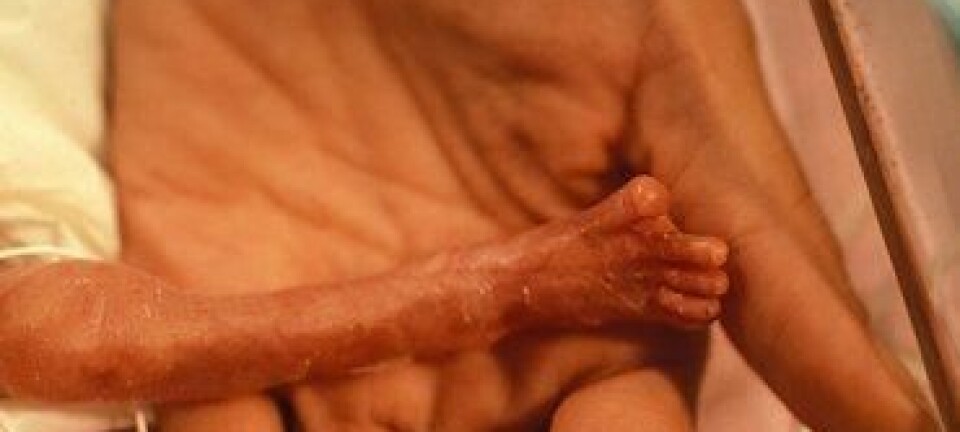
A targeted defence against harmful hemoglobin
Hemoglobin is both vital and life-threatening. A new project sets out to find out how the body deals with the problem of harmful hemoglobin, and how this knowledge can be used to save lives.
Hemoglobin is one of the most important components of our blood, as it binds oxygen, which can then be transported around the body.
Hemoglobin is normally encapsulated in red blood cells, but if released into the bloodstream it is dangerous. This is because the molecule can destroy e.g. the body’s cell membranes, which eventually leads to cell death.
In response to this, the human body has developed a mechanism for capturing and neutralising free hemoglobin in the blood.
Associate Professor Christian Brix Folsted Andersen of the Department of Biomedicine, Aarhus University, has received a grant to study how the body can neutralise free hemoglobin.
Towards a cure for blood diseases
Hemoglobin is a thoroughly examined molecule and one of the first proteins to have its structure mapped out. Little was known, however, about the defence mechanism itself before it was identified in 2001. So there is some way to go, and that’s what we’re working towards now.
The findings from the project, scheduled to take four years, may eventually help patients with blood diseases such as sickle cell anemia, where free hemoglobin in the bloodstream can reach critical levels that the natural defence mechanism is unable to fight off.
“Hemoglobin is a thoroughly examined molecule and one of the first proteins to have its structure mapped out. Little was known, however, about the defence mechanism itself before it was identified in 2001. So there is some way to go, and that’s what we’re working towards now,” says Andersen.
The project also aims to make it easier to cure people who suffer from e.g. African sleeping sickness, in which a parasite feeds on the body’s hemoglobin.
A study of bindings
In previous studies, Andersen has shown how hemoglobin binds to another protein in the body, haptoglobin, which binds free hemoglobin, rendering it unable to harm the body’s cells.
These findings were published last year in the journal Nature.
Taking it one step further
Today, sleeping sickness is treated with chemotherapy. With an increased understanding of how the African sleeping disease parasite recognises hemoglobin, we may be able to design new drugs for the many people who suffer from the disease.
With the new project, the researcher is taking things one step further by examining how the the hemoglobin-haptoglobin complex is accumulated and neutralised by our immune system’s garbage disposal system, known as macrophages.
By binding the hemoglobin-haptoglobin complex to certain surface receptors, the macrophages can absorb the hemoglobin and break it down with some specially-designed enzymes.
“We still don’t know how the receptors on the surface of the macrophages recognise the complex,” says Andersen. “That’s what my research group will be spending the next four years trying to figure out.”
X-ray crystallography
The researchers will be using a technique known as X-ray crystallography.
First, they will be isolating and purifying the molecules that play a part in this vital process.
They will then try to crystallise the molecules, which essentially involves shooting in the dark with a mixture of the molecules in a variety of solvents and salts that make the molecules form a crystal lattice of up to a quarter of a millimetre.
Only when the crystals have been created can the researchers send X-rays through them to form a picture of how the various atoms are placed in relation to one another, and thus also how the various parts of the molecules bind to one another.
”It may sound simple, but it’s a lengthy process with many time-consuming experiments and clarifications. Sometimes it takes years for any results to emerge, so this requires a bit of patience.”
Cure against African sleeping sickness
The second part of the project involves the dreaded African sleeping disease, which killed 48,000 African people in 2008 when the disease turned into an epidemic.
Like the macrophages, the sleeping sickness parasite can capture hemoglobin, using it as nutrition while multiplying in the blood.
Scientists have yet to figure out why this parasite binds to the hemoglobin:
”African sleeping disease is a disease that travels from the bloodstream into the central nervous system, where it can cause paralysis and a highly irregular sleep pattern,” says Andersen.
“Today, sleeping sickness is treated with chemotherapy. With an increased understanding of how the African sleeping disease parasite recognises hemoglobin, we may be able to design new drugs for the many people who suffer from the disease.”
-------------------------
Read the Danish version of this article at videnskab.dk







